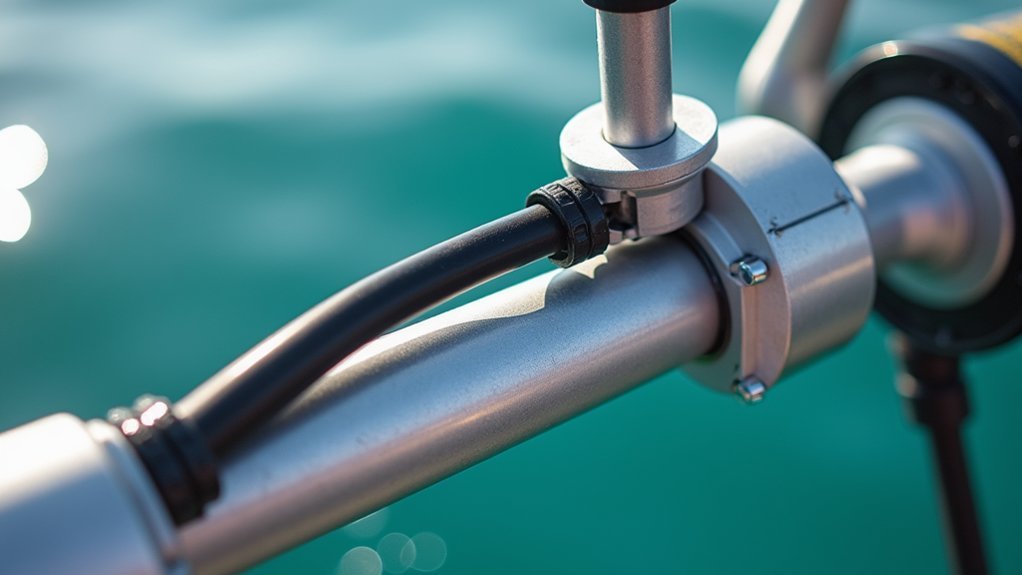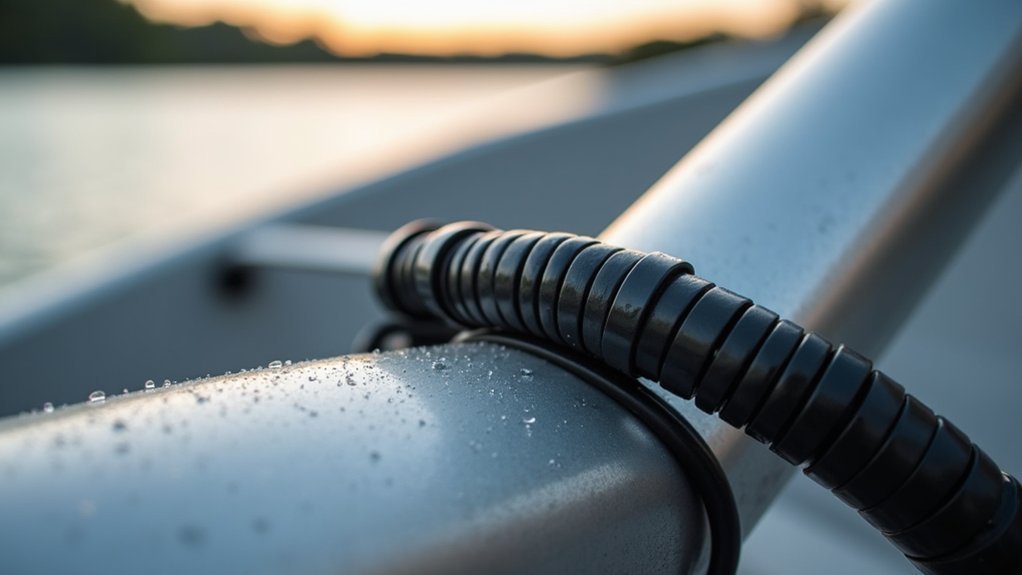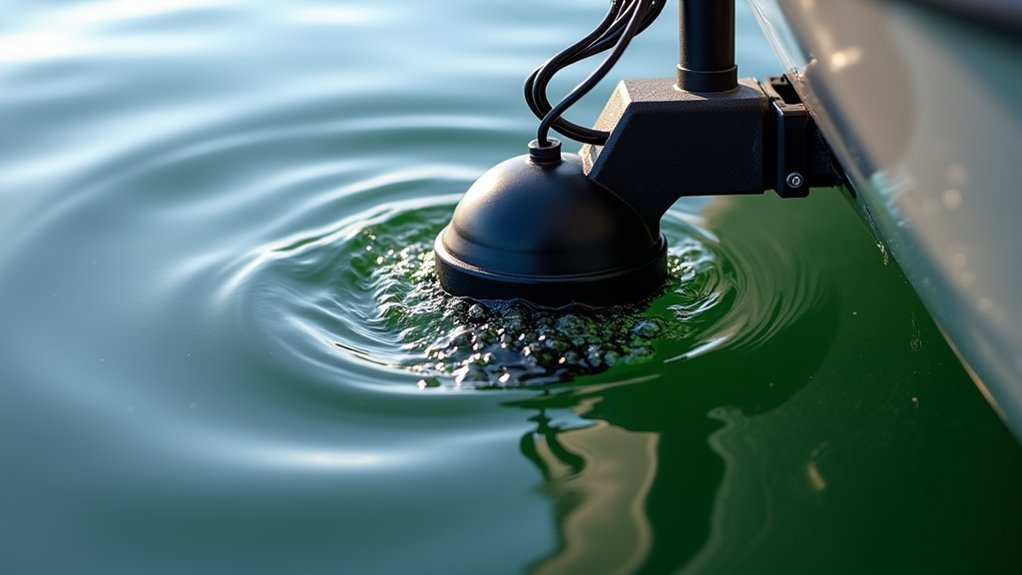We've all faced those frustrating moments when our fish finder gives us nothing but static and unclear images. That's why mounting transducers behind fish finder shafts has become a game-changing technique for serious anglers. By positioning the transducer in this strategic spot, we're not just improving signal quality – we're revolutionizing how clearly we can see what's beneath our boats. Let's explore why this mounting method might be the solution you've been searching for.
Optimal Signal Reception Through Shaft Positioning
When it comes to getting the clearest sonar readings from your fish finder, positioning the transducer behind the shaft makes perfect sense. We'll show you why this mounting location delivers superior performance on the water.
When properly mounted behind the shaft, your transducer's signal passes through unobstructed, giving you the best possible reception. The shaft acts like a protective shield, keeping turbulent water and pesky air bubbles away from the transducer face. This clean flow of water is pivotal for maintaining crystal-clear images of what's below.
We've found that this transom setup also helps direct the sonar signal straight down into the water, maximizing your coverage area. By keeping the transducer away from hull irregularities, you'll get reliable readings even at higher speeds.
Structural Benefits of Behind-Shaft Mounting
Several key structural advantages make mounting your transducer behind the shaft an excellent choice for protecting your investment. We'll show you why this setup delivers the protection and accessibility you need for worry-free fishing adventures.
The shaft acts as a natural shield, keeping your transducer cable safe from unexpected impacts and snags that could otherwise damage your equipment.
You'll have a secure mounting position that holds your transducer at the perfect angle for ideal performance.
When it's time for maintenance or adjustments, you can easily access your transducer without any hassle.
The behind-shaft mount keeps your transducer clear of other boat components, giving you more freedom to customize your setup while maintaining clean, organized equipment placement.
Interference Reduction Techniques

By mounting transducers behind fish finder shafts, we can substantially reduce interference that often plagues sonar readings. The ideal transducer position helps eliminate two major sources of distortion – turbulence and air bubbles. When we place the transducer behind the shaft, it stays in cleaner, bubble-free water, giving us much clearer images of what's beneath our boats.
For maximum interference reduction, we'll want to keep the transducer at least 6 inches behind the shaft. This distance guarantees that any disturbed water has settled before reaching our sonar equipment. We can also angle the transducer slightly downward, which helps prevent surface noise from affecting our readings. These simple adjustments make a huge difference in getting reliable fish finder performance on the water.
Performance Impact on Fish Detection
Mounting transducers behind fish finder shafts creates substantial challenges for accurate fish detection. When we're out on the water, proper transducer placement makes all the difference in getting clear sonar readings. We've found that positioning the transducer behind the trolling motor shaft severely limits our ability to spot fish effectively.
Water turbulence from the shaft creates disruptive air bubbles that interfere with sonar signals. Shadow zones appear on our fish finder display, making it harder to interpret what's below. The disrupted water flow reduces our depth reading capabilities and signal strength. Our overall fish detection accuracy drops drastically due to distorted sonar returns.
Let's face it – if we want the freedom to find fish reliably, we need to position our transducers away from shaft-induced turbulence for the best results.
Cable Management and Protection

A well-protected transducer cable makes all the difference in maintaining reliable fish finder performance. When we mount the transducer behind the shaft, we're giving that essential cable the protection it needs. Let's look at how this setup keeps your system running smoothly:
| Protection Point | When Mounted Behind | Risk if Exposed |
|---|---|---|
| Cable Route | Inside motor housing | Snagging hazard |
| Connection Point | Sheltered from water | Corrosion risk |
| Cable Length | Organized path | Excess slack |
| Access | Easy maintenance | Difficult repairs |
| Durability | Extended life | Regular replacement |
Once the transducer is mounted correctly, you'll appreciate how the shaft creates a natural shield for your cable. This setup keeps everything neat and protected, giving you more time to focus on finding fish rather than fixing equipment.
Alignment Strategies for Maximum Coverage
Getting your transducer's alignment just right can make the difference between seeing every fish or missing the action entirely. When we've mounted the transducer behind the fish finder shaft, proper alignment becomes essential for maximum coverage.
Let's get your new transducer working at its best with these key strategies.
- Position your transom mount transducer with a slight downward angle to match your boat's natural ride
- Keep the transducer face parallel to the water surface for the clearest sonar returns
- Use adjustable brackets to fine-tune the position and minimize disturbance
- Test the alignment at various speeds to confirm consistent performance
With these alignment techniques, we'll have you scanning the waters like a pro, capturing every detail of what's swimming below your boat.
Depth Reading Accuracy Improvements

The strategic position of your transducer behind the fish finder's shaft can dramatically improve the accuracy of your depth readings.
When you're out trolling, the motor and shaft create turbulent water flow that can confuse your readings, but we've got a simple solution for that.
Frequently Asked Questions
Where Should I Mount My Fish Finder Transducer?
Let's help you find the ideal transducer location! We recommend mounting it on your transom for stability or trolling motor for versatility. Just guarantee it's away from turbulence and propeller wash.
Where Is the Best Place to Put a Side Imaging Transducer?
We'll get the best side imaging by mounting our transducer on the hull's exterior, as far forward as possible, angled 20-30 degrees down, away from turbulent water zones for ideal orientation.
Is It Better to Mount a Transducer on a Transom or Trolling Motor?
Like choosing your perfect fishing spot, transducer position depends on your style. We'd recommend transom placement for trolling and casting from back, while trolling motor mounting's ideal location for bow fishing.
Where Do You Mount a Lowrance Transducer?
We can mount your Lowrance transducer through hull, on hull, or typically on the starboard side of your transom. Each option works well, but transom mounting offers the most flexibility and easiest access.